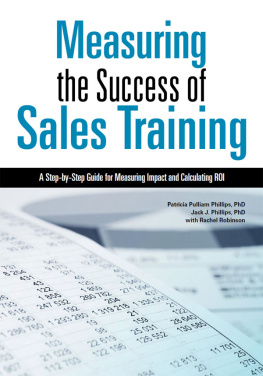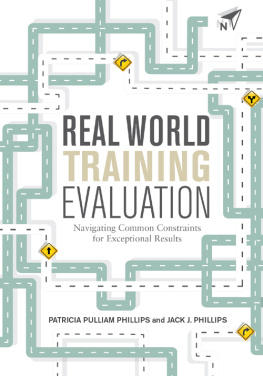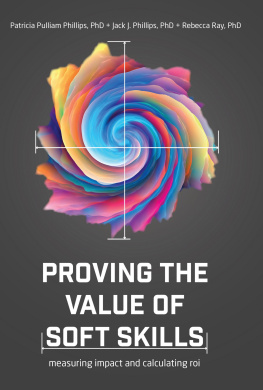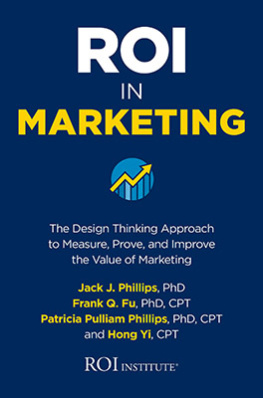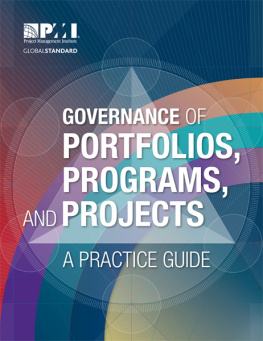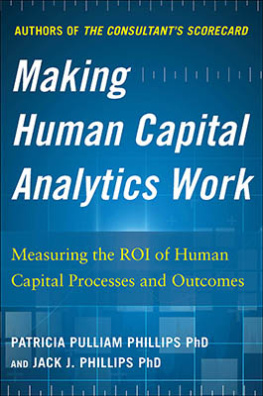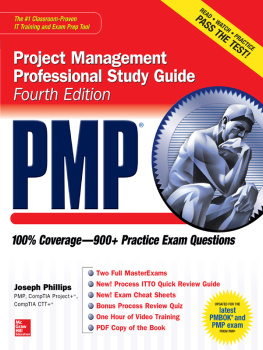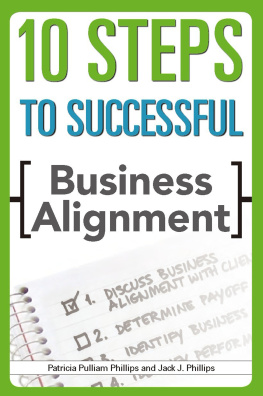Contents
Guide
Page List
Show the Value of What You Do
Show the Value of What You Do
MEASURING AND ACHIEVING SUCCESS IN ANY ENDEAVOR
Patricia Pulliam Phillips
CEO of ROI Institute
Jack J. Phillips
Chair of ROI Institute

Show the Value of What You Do
Copyright 2022 by Patricia Pulliam Phillips and Jack J. Phillips
All rights reserved. No part of this publication may be reproduced, distributed, or transmitted in any form or by any means, including photocopying, recording, or other electronic or mechanical methods, without the prior written permission of the publisher, except in the case of brief quotations embodied in critical reviews and certain other noncommercial uses permitted by copyright law. For permission requests, write to the publisher, addressed Attention: Permissions Coordinator, at the address below.

| Berrett-Koehler Publishers, Inc.
1333 Broadway, Suite 1000
Oakland, CA 94612-1921
Tel: (510) 817-2277, Fax: (510) 817-2278
www.bkconnection.com |
Ordering information for print editions
Quantity sales. Special discounts are available on quantity purchases by corporations, associations, and others. For details, contact the Special Sales Department at the Berrett-Koehler address above.
Individual sales. Berrett-Koehler publications are available through most bookstores. They can also be ordered directly from Berrett-Koehler: Tel: (800) 929-2929; Fax: (802) 864-7626; www.bkconnection.com
Orders for college textbook/course adoption use. Please contact Berrett-Koehler: Tel: (800) 929-2929; Fax: (802) 864-7626.
Distributed to the U.S. trade and internationally by Penguin Random House Publisher Services.
Berrett-Koehler and the BK logo are registered trademarks of Berrett-Koehler Publishers, Inc.
First Edition
Paperback print edition ISBN 978-1-5230-0227-6
PDF e-book ISBN 978-1-5230-0228-3
IDPF e-book ISBN 978-1-5230-0229-0
Digital audio ISBN 978-1-5230-0230-6
2022-1
Book producer: Westchester Publishing Services
Cover designer: Matt Avery
THIS BOOK IS DEDICATED
to our family
who always support us in all our endeavors,
to our amazing team at ROI Institute
who provide excellent service to our customers, and
to our loyal customer base
who inspire us to do our very best.
Contents
INTRODUCTION
Delivering Success
Sometimes the value of the work, the projects you undertake, or the initiatives you tackle are unclear. In this era of evidence-based inquiry, value needs to be credible, accurate, and compelling. ROI Institute has been addressing this issue with a process called the ROI Methodology for the past three decades.
The Show the Value Process is a simplified version of the Return on Investment (ROI) Methodology. This book describes six easy steps to measure and improve the success of any project, program, initiative, or work that you do. It will help you avoid disappointing results by designing for and delivering the desired outcome. It is logical, credible, and easy to use.
We developed the ROI Methodology in the 1970s and refined it in the 1980s when the first book describing the process was published. It was implemented globally in the 1990s and since then has become one of the most used evaluation systems in the world, as it is used routinely in more than 6,000 organizations in 70 countries. Our team has written over 75 books to support the ROI Methodology, including case study contributions from users of the process. Over the years, we have refined the process to make it more successful, with users approving the standards guiding it. In essence, the ROI Methodology is a credible, CEO-friendly, and user-centered process. With our team, we have trained more than 50,000 managers and professionals in the ROI Methodology. And, we have used the methodology in thousands of studies to measure the impact and ROI of projects, programs, and initiatives.
But lets face it, data and data analysis frighten people, ROI frightens people, and a 500-page book really frightens people! It doesnt have to be this way. Our process is relatively simple. It provides a way of thinking about the work that you do, the projects that you pursue, and the definition you place on success. It helps you think about how to drive success and measure that success at different levels and from different perspectives. It also helps you decide if the project is worth implementing. The Show the Value Process described in this book will make a difference in your work and the projects you undertake.
THREE GOALS FOR THIS BOOK
The first goal is to help individuals and teams achieve and measure the success of any new project, program, or initiative. For example, Reverend Doug Stewart shows the value of having a chaplain in the intensive care unit; Katie Westwood shows the value of a tuition refund program for a Fortune 50 company; Major Chip Huth, a police SWAT team leader, shows the value of a leadership program designed to reduce complaints about excessive force; Paula Patel shows the value of working at home; Anna Chen shows the value of a Leader in Me program to make seventh and eighth grade students more successful; and, finally, Sarah Robertson needed to show the value of counseling at a food bank. These are just six of the dozens of stories presented in the book, illustrating the vast applications of this process.
A review of applications that use this process reveals that it works in any situation and any work, job, or project for individuals and organizations. In addition to being effective in businesses, it is effective in governments, nongovernmental organizations (NGOs), nonprofits, school systems, charities, foundations, and associations. It works in different countries with all types of initiatives, from very soft programs, such as coaching, to hard programs, such as implementing a new IT system.
A second goal is to shift the thinking about projects and work from merely completed activities to investments that deliver impact. There are many misconceptions about what success means, and success itself varies. We mistakenly assume that you achieve success just by doing something. While activity is necessary, success comes when the activitys impact or consequence is evident. For example, historically, managers would applaud employee performance based on their workload, the length of the task completion list, and the fact that employees are visible at the office. Today, flexible work arrangements require a new way of measuring employee success on the job. No longer is performance measured by what people do and where they do it. Today, performance is measured by outcomes and the quality of those outcomes. Mere activity without a purposeful consequence means littleit is just being busy.
A third goal is to help you use project results to make improvements, increase support, and perhaps secure more funding in the future. The work is not over upon delivery of a successful project. It is vital to leverage a projects success for maximum results, and one way to do this is to always improve the project the next time around.


